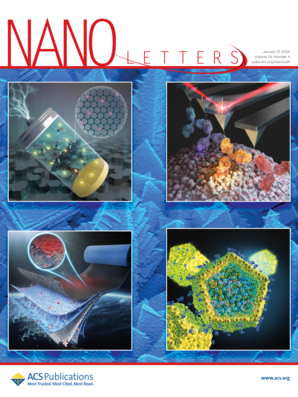环境条件下非激子共振激发下WS2薄片的边缘取向表面等离子体和面外声子耦合操纵Davydov分裂
IF 9.6
1区 材料科学
Q1 CHEMISTRY, MULTIDISCIPLINARY
引用次数: 0
摘要
二维(2D)材料与范德华(vdW)相互作用推动了电子、光学和材料科学的重大进步。控制和理解层间相互作用对于扩展其潜在应用至关重要。与声子-电子-激子耦合动力学相关的Davydov分裂提供了一种研究和评估二维vdW材料层间相互作用的方法。在这里,我们报道了在环境条件下放置在金薄膜边缘的10纳米厚的WS2薄片中观察到明显的面外模式Davydov分裂。由于OP声子与边缘等离子体之间的耦合,OP模式的拉曼强度增加了1000倍以上,并伴有通过偏振入射光和表面等离子体控制的分裂峰。非激子共振激发下等离子体-声子耦合诱导的分裂为控制多层二维材料的层间耦合提供了一种新方法,为操纵vdW同质结构和异质结构中的量子现象提供了进一步的机会。本文章由计算机程序翻译,如有差异,请以英文原文为准。

Edge-Oriented Surface Plasmons and Out-of-Plane Phonon-Coupling-Manipulated Davydov Splitting in WS2 Flakes with Nonexciton Resonance Excitation under Ambient Conditions
Two-dimensional (2D) materials with van der Waals (vdW) interactions have driven significant advancements in electronics, optics, and materials science. Controlling and understanding interlayer interactions are crucial to expanding their potential applications. Davydov splitting, which is associated with phonon–electron–exciton-coupling dynamics, offers a method to investigate and assess interlayer interactions in 2D vdW materials. Here we report a significant Davydov splitting of the out-of-plane (OP) mode observed in 10-nm-thick WS2 flakes placed at the edge of gold thin films under ambient conditions. The Raman intensity of the OP mode increased over 1000-fold due to the coupling between OP phonons and edge-oriented plasmons, accompanied by a splitting peak controllable via polarized incident light and surface plasmons. The plasmon–phonon-coupling-induced splitting under nonexciton resonance excitation offers a new approach to controlling interlayer coupling in multilayer 2D materials, unlocking further opportunities for manipulating quantum phenomena in vdW homostructures and heterostructures.
求助全文
通过发布文献求助,成功后即可免费获取论文全文。
去求助
来源期刊

Nano Letters
工程技术-材料科学:综合
CiteScore
16.80
自引率
2.80%
发文量
1182
审稿时长
1.4 months
期刊介绍:
Nano Letters serves as a dynamic platform for promptly disseminating original results in fundamental, applied, and emerging research across all facets of nanoscience and nanotechnology. A pivotal criterion for inclusion within Nano Letters is the convergence of at least two different areas or disciplines, ensuring a rich interdisciplinary scope. The journal is dedicated to fostering exploration in diverse areas, including:
- Experimental and theoretical findings on physical, chemical, and biological phenomena at the nanoscale
- Synthesis, characterization, and processing of organic, inorganic, polymer, and hybrid nanomaterials through physical, chemical, and biological methodologies
- Modeling and simulation of synthetic, assembly, and interaction processes
- Realization of integrated nanostructures and nano-engineered devices exhibiting advanced performance
- Applications of nanoscale materials in living and environmental systems
Nano Letters is committed to advancing and showcasing groundbreaking research that intersects various domains, fostering innovation and collaboration in the ever-evolving field of nanoscience and nanotechnology.
 求助内容:
求助内容: 应助结果提醒方式:
应助结果提醒方式:


